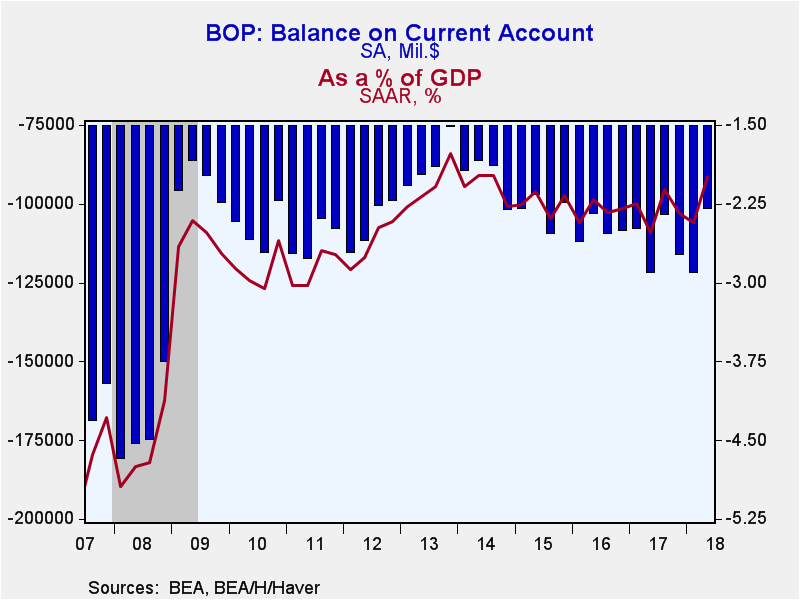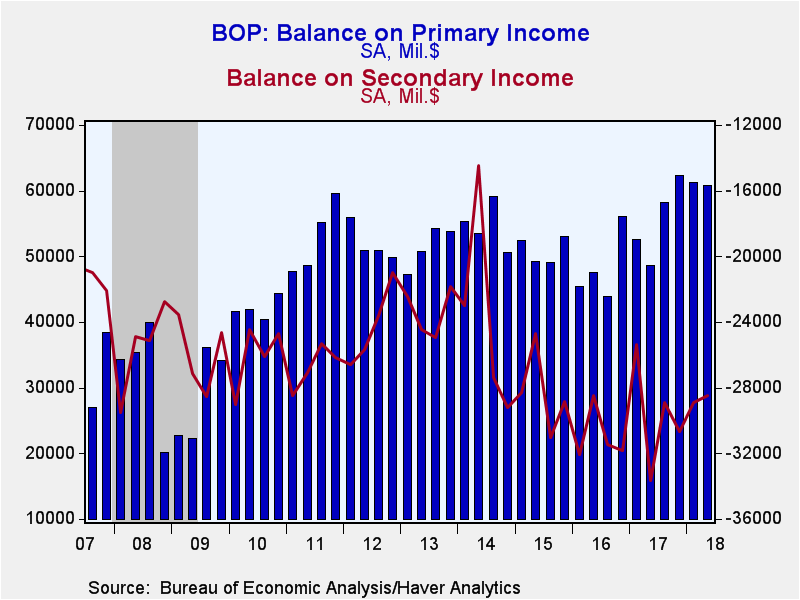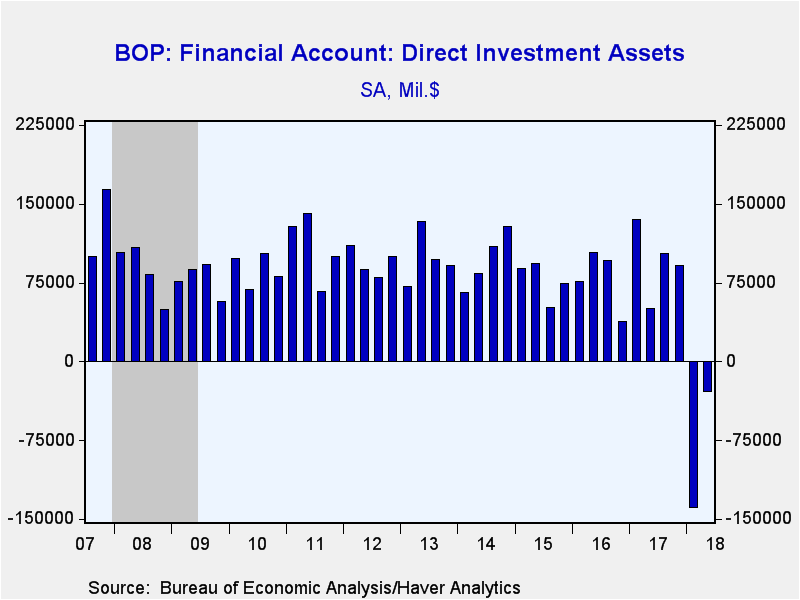 Global| Sep 19 2018
Global| Sep 19 2018U.S. Current Account Deficit Declines
by:Tom Moeller
|in:Economy in Brief
Summary
The U.S. current account deficit fell to $101.5 billion during Q2 2018 from $121.7 billion in Q1. It was the smallest deficit since Q4 2015 and compared to $103.5 billion expected in the Action Economics Forecast Survey. As a percent [...]
The U.S. current account deficit fell to $101.5 billion during Q2 2018 from $121.7 billion in Q1. It was the smallest deficit since Q4 2015 and compared to $103.5 billion expected in the Action Economics Forecast Survey. As a percent of GDP, the deficit declined to 2.0% from 2.4%.
The smaller deficit last quarter was partly due to a shallower $203.2 billion shortfall on goods trade. Goods exports increased 4.3%, while goods imports held steady.
Additionally, the surplus on services trade increased to a record $69.3 billion. Services exports rose 1.5%. Telecommunications, computer & information services exports gained 2.5% (8.2% y/y). Exports of intellectual property rights rose 1.8% (6.1% y/y) while travel exports rose 0.6% (2.7% y/y). Services imports gained 0.4%. Charges for intellectual property declined 1.5% (-11.5% y/y) and travel imports increased 0.1% (6.2% y/y). Telecommunications, computer & information services imports rose 1.7% (5.5% y/y).
The surplus on primary income eased to $60.8 billion, but remained near the record high. The deficit on secondary income also slipped to $28.5, and remained narrower y/y.
From the capital account, the deficit on foreign direct investment shrank to $29.1 billion. This year's deficits compare to surpluses through most of the post-war period.
Balance of Payments data are in Haver's USINT database, with summaries available in USECON. The expectations figure is in the AS1REPNA database.
| US Balance of Payments SA | Q2'18 | Q1'18 | Q4'17 | 2017 | 2016 | 2015 |
|---|---|---|---|---|---|---|
| Current Account Balance ($ Billion) | -101.5 | -121.7 | -116.1 | -449.1 | -432.9 | -409.8 |
| Deficit % of GDP | -2.0 | -2.4 | -2.3 | -2.3 | -2.3 | -2.2 |
| Balance on Goods ($ Billion) | -203.2 | -220.8 | -212.4 | -807.5 | -751.1 | -761.9 |
| Exports | 4.3% | 2.4% | 3.6% | 6.6% | -3.6% | -7.6% |
| Imports | 0.0% | 2.9% | 5.1% | 6.9% | -2.9% | -4.7% |
| Balance on Services ($ Billion) | 69.3 | 66.8 | 64.6 | 255.2 | 249.1 | 263.3 |
| Exports | 1.5% | 1.0% | 1.3% | 5.1% | 0.5% | 1.9% |
| Imports | 0.4% | -0.2% | 1.6% | 6.4% | 3.6% | 2.3% |
| Balance on Primary Income ($ Billion) | 60.8 | 61.2 | 62.4 | 221.7 | 193.0 | 203.6 |
| Balance on Secondary Income ($ Billion) | -28.5 | -28.9 | -30.7 | -118.6 | -123.9 | -112.8 |
Tom Moeller
AuthorMore in Author Profile »Prior to joining Haver Analytics in 2000, Mr. Moeller worked as the Economist at Chancellor Capital Management from 1985 to 1999. There, he developed comprehensive economic forecasts and interpreted economic data for equity and fixed income portfolio managers. Also at Chancellor, Mr. Moeller worked as an equity analyst and was responsible for researching and rating companies in the economically sensitive automobile and housing industries for investment in Chancellor’s equity portfolio. Prior to joining Chancellor, Mr. Moeller was an Economist at Citibank from 1979 to 1984. He also analyzed pricing behavior in the metals industry for the Council on Wage and Price Stability in Washington, D.C. In 1999, Mr. Moeller received the award for most accurate forecast from the Forecasters' Club of New York. From 1990 to 1992 he was President of the New York Association for Business Economists. Mr. Moeller earned an M.B.A. in Finance from Fordham University, where he graduated in 1987. He holds a Bachelor of Arts in Economics from George Washington University.










